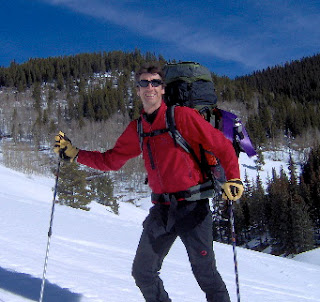Stuff I Learned - Week #13
This past week I've been learning about how high altitude impacts physical activity. As many of you have probably experienced, hiking in the mountains of Colorado can be more fatiguing than hiking in Wisconsin's Blue Mound State Park. Why is it much easier for a flatlander to exercise in the hills of Southern Wisconsin's Driftless region than to exercise in Colorado's high country?
Atmospheric pressure rapidly decreases as altitude increases, and as a result, there's a lot less oxygen available at Monarch Mountain Ski Area in Colorado than there is at Tyrol Basin here in Wisconsin. While this decrease in available oxygen may seem like the beginning and end of the story, the physiology is actually much more interesting than simply more/less oxygen.
 |
| Earning turns outside of Leadville, CO (huffing and puffing every step of the way) |
Let's start with looking at how your body responds to an environment that has less available oxygen (hypoxic). A few weeks ago I discussed the feedback mechanisms that determine respiratory rate, and those same mechanisms are at play in the hypoxic state. With less available oxygen in the inhaled air, the chemoreceptors in the aorta and carotid arteries signal the respiratory centers of the brain-stem to increase the depth and rate of the breathing.
In addition to the increased rate and depth of the breathing, heartrate also increases when you're moving around in the high country. (Have you ever experienced the feeling that your heart was going to fly out of your chest while skiing in the mountains?)
The increase in heartrate and respiratory volume that occurs in the mountains is a good start in adapting to the lower-oxygen conditions, though these cardiorespiratory adaptations are still insufficient to fully compensate for the hypoxia. There is still insufficient oxygen getting to your working muscles - as hard as you may be breathing when you're skiing, it still isn't hard enough!
 |
| There's not much oxygen at the top of Mt. Kangchenjunga. At 28,169 feet above sea level, tying your shoes is exhausting. |
As I mentioned earlier, the sensors in the carotid arteries and aorta are sensing a deficit in oxygen, which signals the respiratory centers to increase the rate and depth of the breathing. So far, so good. Unfortunately, the deeper breathing reduces the levels of carbon dioxide in the muscles. While less carbon dioxide in the muscles may seem like a good thing, the decrease in carbon dioxide corresponds to an alkaline shift in the tissues. As the pH of the tissues moves to an alkaline state, the central and peripheral chemoreceptors signal the brainstem to slow down the breathing in order to bring the pH of the tissues back into balance. As a result, the body is simultaneously trying to speed up and slow down the breathing!
Herein is another example of the brilliance/intelligence of the human body. After spending a few days at altitude, your body figures out how to respond. The central and peripheral chemoreceptors reduce their signaling to the respiratory centers, and as a result of this downregulation, the breathing responds more effectively to the hypoxic conditions. Voila - blood oxygen levels are normalized, and some degree of adaptation to high altitude conditions occurs!
While there is more to high altitude adaptation than this cardiorespiratory signaling effect, I think I'll leave the discussion here for the time being.
For a future posting, let me know if you'd find it interesting to learn how Tibetan and Andean populations, for example, have adapted to thrive at the highest elevations.



Comments